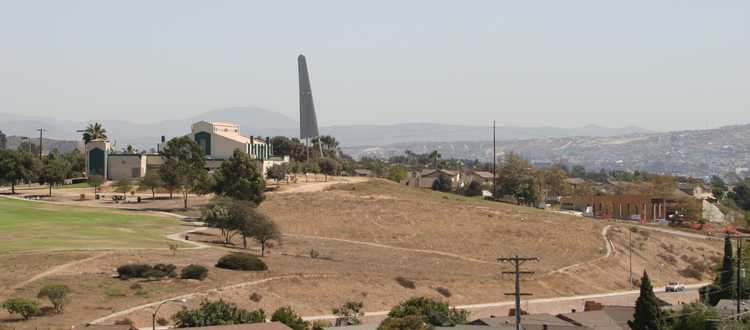John Montgomery
John Joseph Montgomery was born Feb. 15, 1858, in Yuba City, California. He moved to Otay Mesa in 1882 after his father, Zachariah Montgomery, purchased the Fruitlands ranch from the Wilcox family in 1881. This ranch was near the old Rancho La Punta adobe of Santiago Arguello, and also near the ranch home of the Couts family. Santiago Arguello built his nine-room U-shaped adobe for his wife Guadalupe in 1834 and raised a family of six children. Two daughters were married in a double wedding in 1863 at the Rancho Guajome of Cave Couts. Refugio married William Couts, brother of Cave Couts, and Maria Antonia married Alfred H. Wilcox. Thus, by 1882, John Montgomery was a neighbor of the Arguello and Couts and Wilcox families living at La Punta. He began to design his glider in a workshop on the ranch, building flexible wings with pulleys and ropes to control flight, based on his observations of bird wings. His first flight in the glider was a success, from Wheeler Hill at the edge of Otay Mesa, where Silver Wing Park today commemorates the flight with a 90-foot silver wing memorial. On August 28, 1883, John and his brother James transported the 38-pound "aeroplane" (he would be the first to use the word to describe a complete flying machine) to the top of the hill and glided down the hill on the ocean breeze at an average height of 15 feet.
He later described the flight in a 1909 article for Aeronautics Magazine: "The first machine that was constructed was modeled after the gull's wing, following it blindly, going against my reason in the matter but following nature. The wings of a bird are, as you know, curved and, if properly placed at a small angle to the wind, or to the direction of movement, the front surface is inclined downward. This was the stumbling block for me. But the first experiments with this crude device were a success. The apparatus measured 20 feet spread and an average depth, fore and aft, of four and one-half feet. I took this apparatus to the top of a hill facing a gentle wind. There was a little run and a jump, and I found myself launched in the air. I proceeded against the wind, gliding downhill for a distance of six hundred feet. In this experience I was able to direct my course at will. A peculiar sensation came over me. The first feeling in placing myself at the mercy of the wind was that of fear. Immediately after came a feeling of security when I realized the solid support given by the wing-surface. And that support was of a very peculiar nature. There was a cushiony softness about it, yet it was firm. When I found the machine would follow my movements in the seat for balancing, I felt I was self-buoyant . . . " (Spearman p. 7)
Montgomery kept this flight secret and continued working on gliders until he was able to patent his aeroplane design in 1906 (Patent No. 831,173). As a result, there developed some confusion over the year of the first flight from Otay Mesa. The first public account of the gliders was by Octave Chanute in his 1894 book Progress in Flying Machines. Chanute mistakenly recorded the length of the flight as 100 feet rather than 600 feet. The 1909 article in Aeronautic Magazine by Montgomery did not mention the year of his flight. Victor Lougheed in his 1909 and 1912 books used the incorrect date of 1884. Arthur Dunning Spearman in his 1967 biography of Montgomery presented solid evidence for the year of 1883. Yet, incorrect dates continue to appear for the first flight, including the 1950 book Famous First Facts that used a wrong date of March 17, 1884.
Montgomery built several gliders after 1883, helped by neighbors Charles Burroughs, Ed Stokes, and Thomas Couts (or Coutts). In 1895 he moved to Oakland and the next year began his career at Santa Clara College. He died in a powered glider accident in 1911 at Evergreen, south of San Jose.
Sources:
- Spearman, Arthur Dunning. John Joseph Montgomery, 1858-1911: Father of Basic Flying. Santa Clara CA: University of Santa Clara Press, 1967.
- Montgomery glider of 1883 replica at the Western Museum of Flight
